Ray Tracing Modeling of Electromagnetic Propagation for On-Chip Wireless Optical Communications
Abstract
1. Introduction
2. Background on Propagation Mechanisms and Optical WiNoC Requirements
3. General Description of the Multi-Core Chip Structure
- Unpacked, where a plane silica slab including the transmitting and the receiving antennas is bounded by two different media on the upper and on the lower side (Figure 3a). The upper region can be either air or a different passivation material, where the former case stands for possible situations with a refraction index in the superstrate lower than in the SiO2. The lower zone can be silicon or metal—in the latter case accounting for possible metallization layers inside the SiO2 or between the SiO2 and the Si regions.
- Packed: where two additional layers are added at the bottom and on the top of the previous stack (Figure 3b). Either plastic or metal can be considered for the bottom region, whereas plastic is the only option for the top half-space.
4. Ray Tracing Propagation Modeling in OWiNoC
4.1. Unpacked Case
4.2. Packed Case
- Γ is the standard Fresnel reflection coefficient at the interface;
- Τ and Τ′ are the outward and the inward transmission coefficients at the silica slab boundaries;
- Ξi is the product of the reflection coefficients related to the rays bouncing in the upper/lower layer;
- Δi accounts for the phase shifts and propagation delays associated with the bouncing effect;
- Λi and Σi take into account the attenuation experienced by the rays bouncing inside the layers, respectively associated with the possible material losses (actually not considered here, where lossless materials are supposed) and with the spatial spreading of the wavefronts. It is worth mentioning that Σi is actually not included in the original formula provided in Reference [23], and it has been here introduced to cope with the lack of respect for the plane wave and layer thinness conditions assumed in Reference [23].
5. Simulation Results and Discussion
5.1. RT Input Data
- Unpacked cases: U_Δstring_XY_GdB, where Δstring sets the width of the silica layer (possible values: “thin”, “medium”, “thick”, see Table 1), X and Y are characters identifying the top and the down media (X = “A”—Air—or “P”—Passivation, and Y = “S”—Silicon—or “M”—Metal) and GdB is the antennas gain value. For instance, the simulation carried out with isotropic radiators within a 10 μm SiO2 slab bounded by air and silicon at the upper and lower interfaces is referred to as “U_medium_AS_0”;
- Packed cases: P_Δstring_XYZ_GdB, where Δstring, X, Y and GdB keep their meaning and Z is a further character setting the material for the bottom layer (possible values: “P”—Plastic—or “M”—metal). Therefore, adding a plastic package to the previous example would correspond to the label “P_medium_ASP_0”.
5.2. RT Simulation Results
- Free Space Zone: before Pr TX and RX are quite close each other and propagation is dominated by the direct path, since the reflected rays are much longer (in relative terms) and undergo almost normal incidence at the interfaces, which corresponds to the greatest reflection loss. Although this zone is quite limited to the near field region in the isotropic case, where RT accuracy is likely to be poor, it nevertheless extends into the far-field region for increasing antenna directivity (as explained in the following Figure 6);
- Premium Zone: a noticeable power gain occurs between Pr and Pf compared to the free space case, likely due to a sort of guiding effect, which sets up within the silica layer. Multipath composition is constructive on average, and first triggers oscillations of the PG, finding then a regular slope with no fades in most of the cases represented in Figure 6. The spatial average of the PG decay in this zone as 1/dα, α < 2.
- Fall Zone: beyond Pf the coherent composition of the reflected paths turns out to have intensity similar to the direct contribution, but opposite phase. Therefore, the overall received power collapses down at a rate worse than free space, as it happens in the well-known 2-rays model often referred to in mobile wireless communication when the ground presence is taken into account [22].
5.3. Preliminary Validation of Results
6. Conclusions
Author Contributions
Funding
Conflicts of Interest
References
- Abdal, S.; Iannazzo, M.; Nemirovsky, M.; Cabellos-Aparicio, A.; Lee, H.; Alarcon, E. On the Area and Energy Scalability of Wireless Network-on-Chip: A Model-Based Benchmarked Design Space Exploration. IEEE Trans. Netw. 2015, 23, 1501–1513. [Google Scholar] [CrossRef]
- Karkar, A.; Mak, T.; Tong, K.-F.; Yakovlev, A. A Survey of Emerging Interconnects for On-Chip Efficient Multicast and Broadcast in ManyCores. IEEE Circuits Syst. Mag. 2016, 16, 58–72. [Google Scholar] [CrossRef]
- Deb, S.; Ganguly, A.; Ppande, P.P.; Belzer, B.; Heo, D. Wireless NoC as Interconnection Backbone for Multicore Chips: Prmises and Challenges. IEEE J. Emerg. Sel. Top. Circuits Syst. 2012, 2, 228–238. [Google Scholar] [CrossRef]
- Werner, S.; Navaridas, J.; Lujan, M. A Survey on Optical Network-on-Chip Architectures. ACM Comput. Surv. 2017, 50, 89. [Google Scholar] [CrossRef]
- Haurylau, M.; Chen, G.; Chen, H.; Zhang, J.; Nelson, N.A.; Albonesi, D.H.; Friedman, E.G.; Fauchet, P.M. On-Chip Optical Interconnect Roadmap: Challenges and Critical Directions. IEEE J. Sel. Top. Quantum Electron. 2006, 12, 1699–17055. [Google Scholar] [CrossRef]
- Matolak, D.W.; Kodi, A.; Kaya, S.; Di Tomaso, D.; Laha, S.; Rayess, W. Wireless Networks-on-Chips: Architecture, Wireless Channel, and Devices. IEEE Wirel. Commun. 2012, 19, 58–65. [Google Scholar] [CrossRef]
- Matolak, D.W.; Kaya, S. Channel Modeling for Wireless Networks-on-Chips. IEEE Commun. Mag. 2013, 51, 180–186. [Google Scholar] [CrossRef]
- Bellanca, G.; Calò, G.; Kaplan, A.E.; Bassi, P.; Petruzzelli, V. Integrated Vivaldi plasmonic antenna for wireless on-chip optical communications. Opt. Express 2017, 25, 16214–16227. [Google Scholar] [CrossRef] [PubMed]
- Zhang, Y.P.; Chen, Z.M.; Sui, M. Propagation Mechanisms of Radio Waves over Intra-Chip Channels With Integrated Antennas: Frequency-Domain Measurements and Time Domain Analysis. IEEE Trans. Antennas Propag. 2007, 55, 2900–2906. [Google Scholar] [CrossRef]
- Yan, L.; Hanson, G.W. Wave Propagation Mechanisms for Intra-Chip Communications. IEEE Trans. Antennas Propag. 2009, 57, 2715–2724. [Google Scholar] [CrossRef]
- Nafari, M.; Feng, L.; Jornet, J.M. On-chip Wireless Optical Channel Modeling for Massive Multi-core Computing Architectures. In Proceedings of the 2017 IEEE Wireless Communications and Networking Conference (WCNC), San Francisco, CA, USA, 19–22 March 2017. [Google Scholar]
- Yang, Y.; Li, Q.; Qiu, M. Broadband nanophotonic wireless links and networks using on-chip integrated plasmonic antennas. Sci. Rep. 2016, 6, 19490. [Google Scholar] [CrossRef] [PubMed]
- Garcia-Meca, C.; Lechago, S.; Brimont, A.; Griol, A.; Mas, S.; Sanchez, L.; Bellieres, L.; Losilla, N.S.; Martì, J. On-chip wireless silicon photonics: From reconfigurable interconnects to lab-on-chip devices. Light Sci. Appl. 2017, 6, e17053. [Google Scholar] [CrossRef] [PubMed]
- Wu, Z. Electromagnetic Surface Waves. In Encyclopedia of RF and Microwave Engineering; Wiley and Sons: Hoboken, NJ, USA, 2005; pp. 1270–1280. [Google Scholar]
- Barlow, H.M.; Cullen, A.L. Surface Waves. Proc. IEEE Part III 1953, 100, 329–341. [Google Scholar] [CrossRef]
- Collin, R.E. Surface Waveguides. In Field Theory of Guided Waves, 2nd ed.; Wiley-IEEE Press: New York, NY, USA, 1990; pp. 697–748. ISBN 978-0879422370. [Google Scholar]
- Rich, J.C. The launching of a plane surface wave. Proc. IEE Part B Radio Electron. Eng. 1955, 102, 237–246. [Google Scholar] [CrossRef]
- Rabaey, J.M.; Chandrakasan, A.; Nikolic, B. Digital Integrated Circuits: A Design Perspective, 2nd ed.; Pearson: London, UK, 2002; pp. 41–69. ISBN 978-0130909961. [Google Scholar]
- Deng, T.; Zhang, Y.P. On-Chip Antennas. In Handbook of Antenna Technologies; Springer: Singapore, 2016; pp. 1565–1584. ISBN 978-981-4560-43-6. [Google Scholar]
- Pan, S.; Capolino, F. Design of a CMOS On-Chip Slot Antenna with Extremely Flat Cavity at 140 GHz. IEEE Antennas Wirel. Ppropag. Lett. 2011, 10, 827–830. [Google Scholar] [CrossRef]
- Narde, R.S.; Mansoor, N.; Ganguly, A.; Venkataraman, J. On-Chip Antennas for Inter-Chip Wireless Interconnections: Challenges and Opportunities. In Proceedings of the 12th IEEE European Conference on Antennas and Propagation (EuCAP2018), London, UK, 9–13 April 2018. [Google Scholar]
- Bertoni, H.L. Wireless Propagation for Modern Wireless Systems; Prentice Hall: Upper Saddle River, NJ, USA, 2000; pp. 86–106. ISBN 978-0130263735. [Google Scholar]
- Burnside, W.; Burgener, K. High frequency scattering by a thin lossless dielectric slab. IEEE Trans. Antennas Propag. 1983, 31, 104–110. [Google Scholar] [CrossRef]
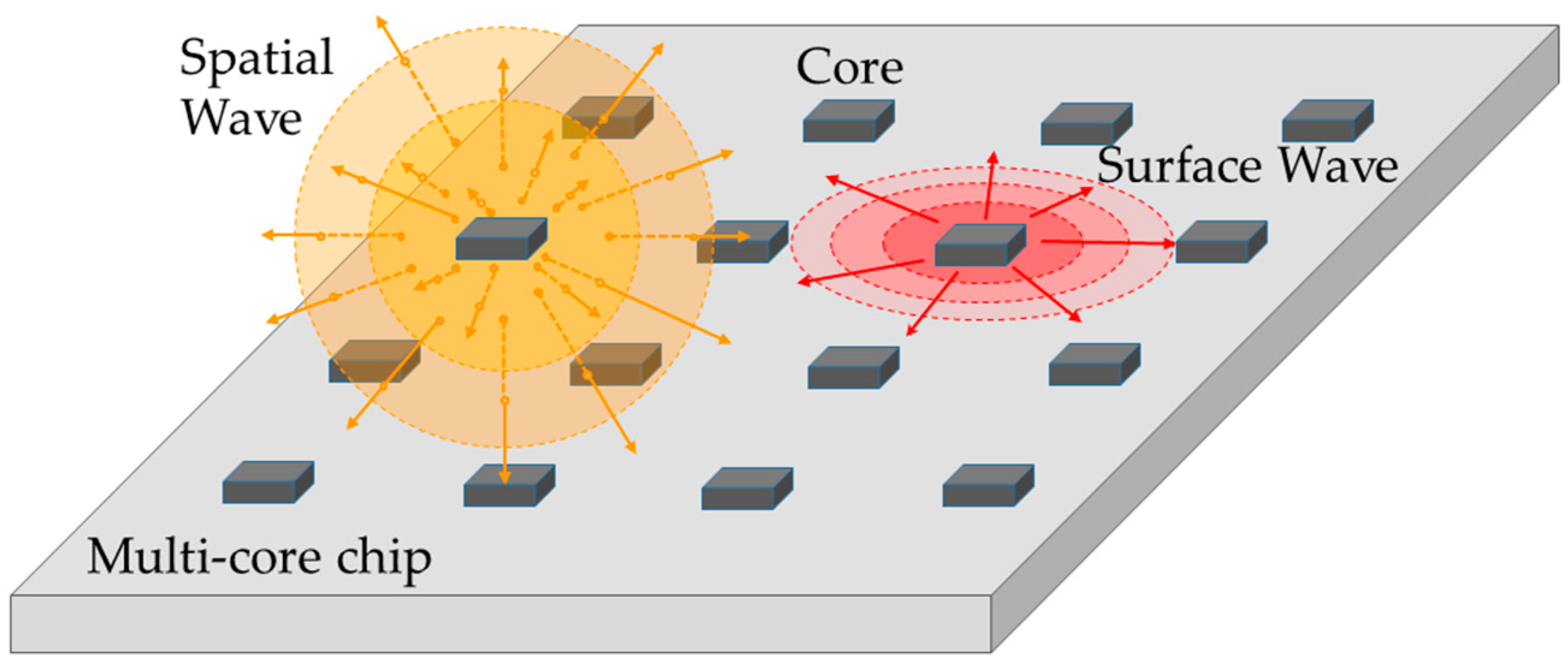

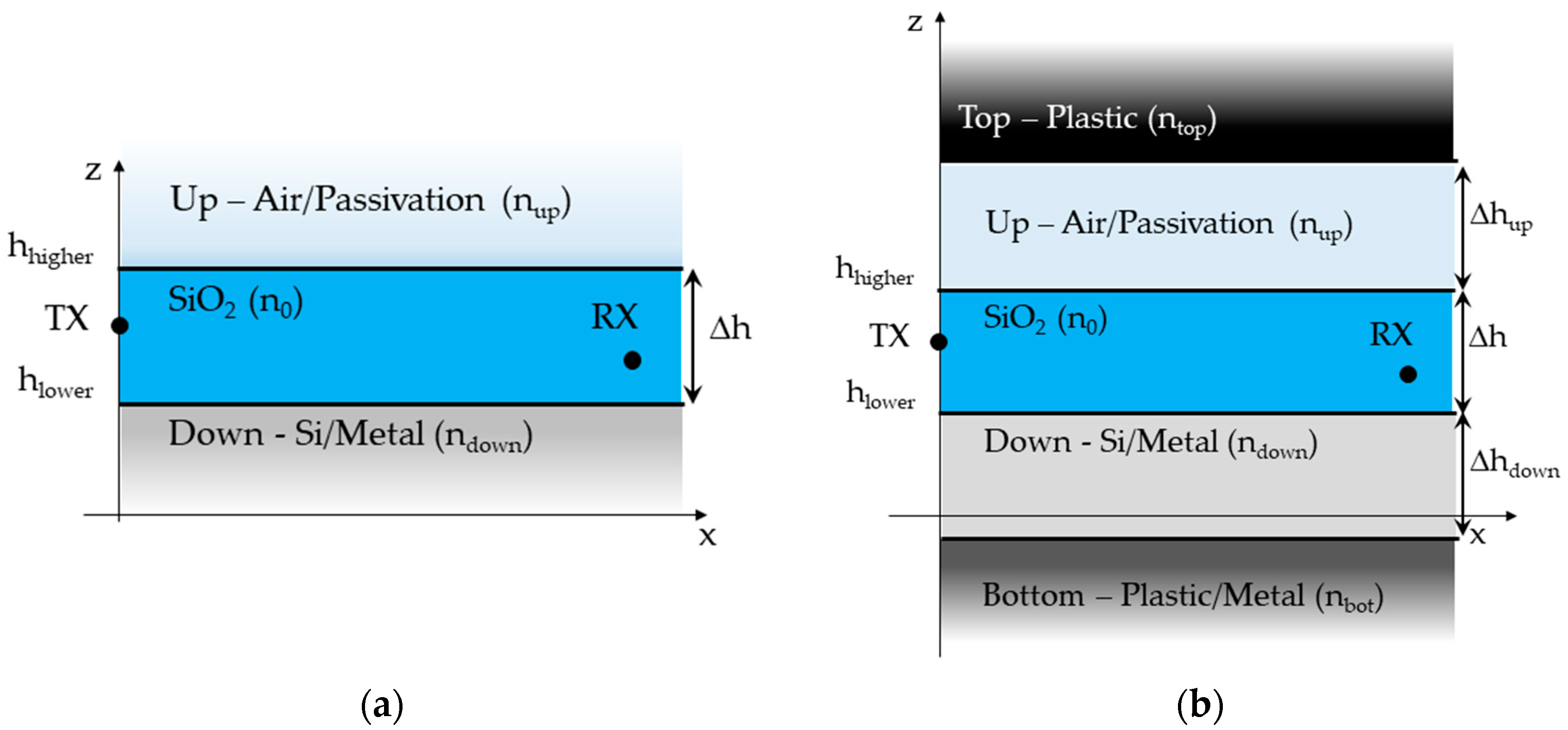
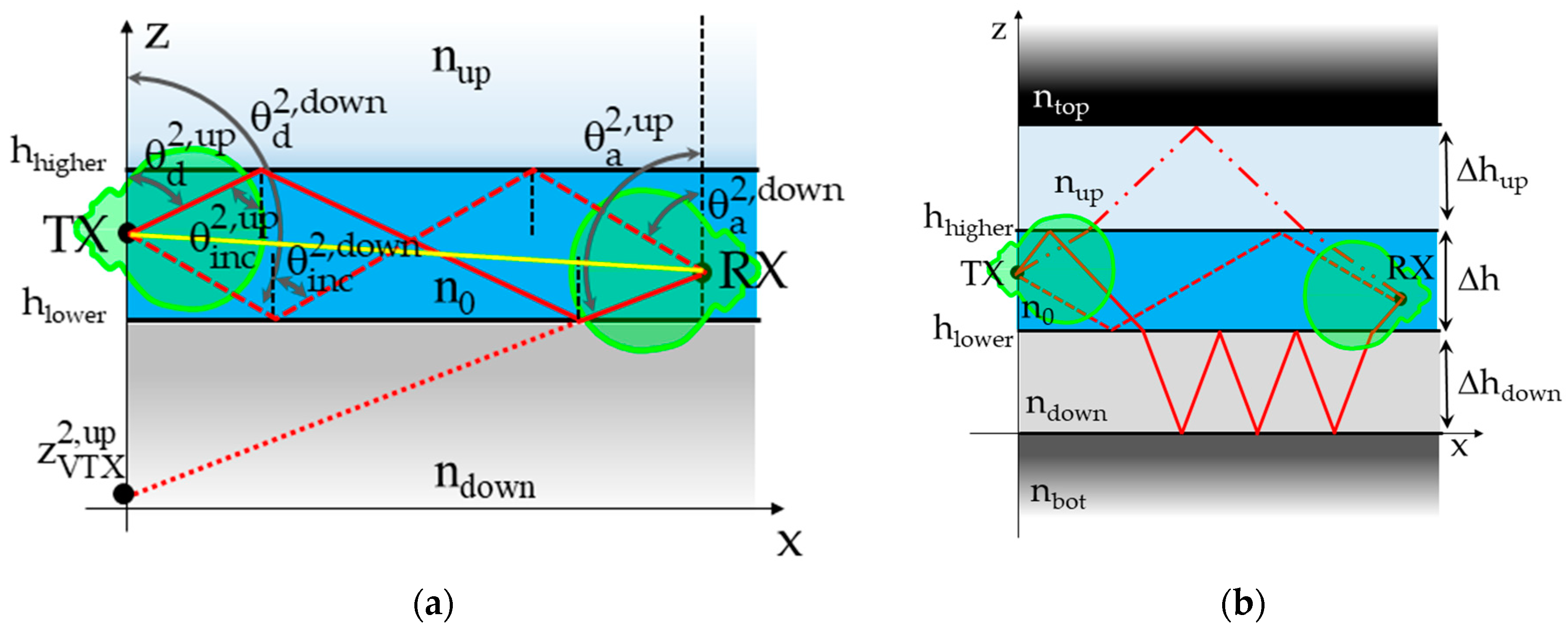
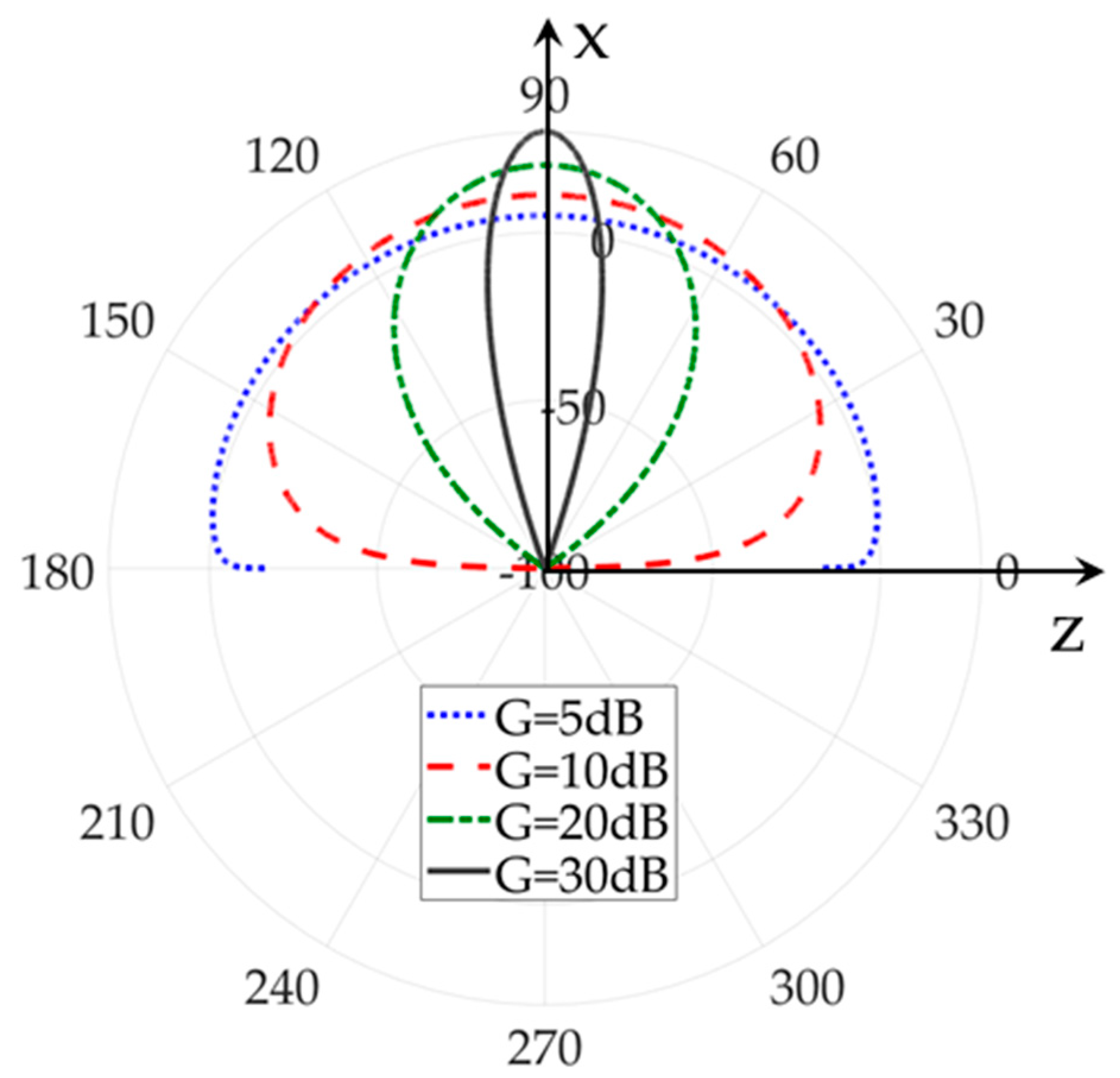
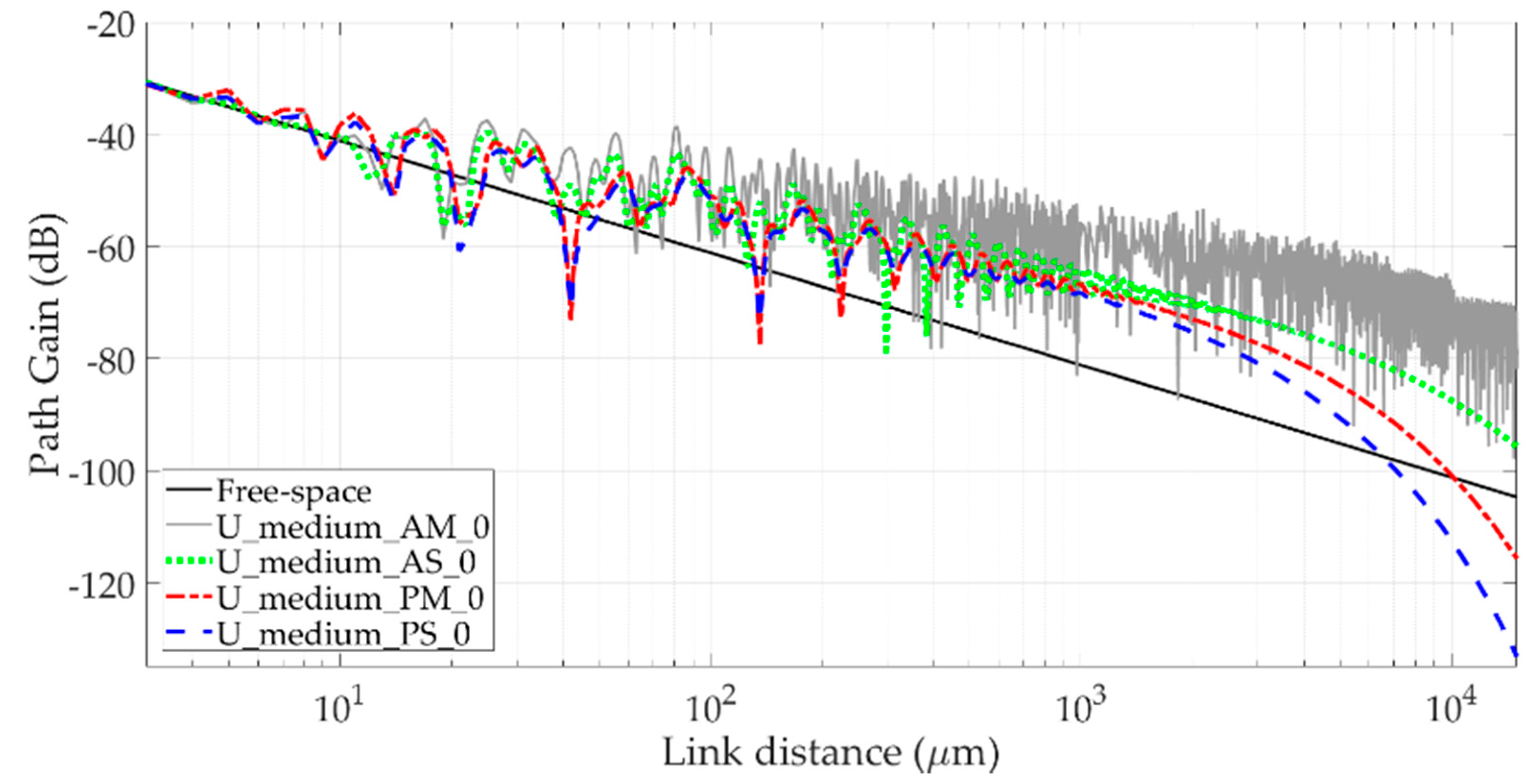
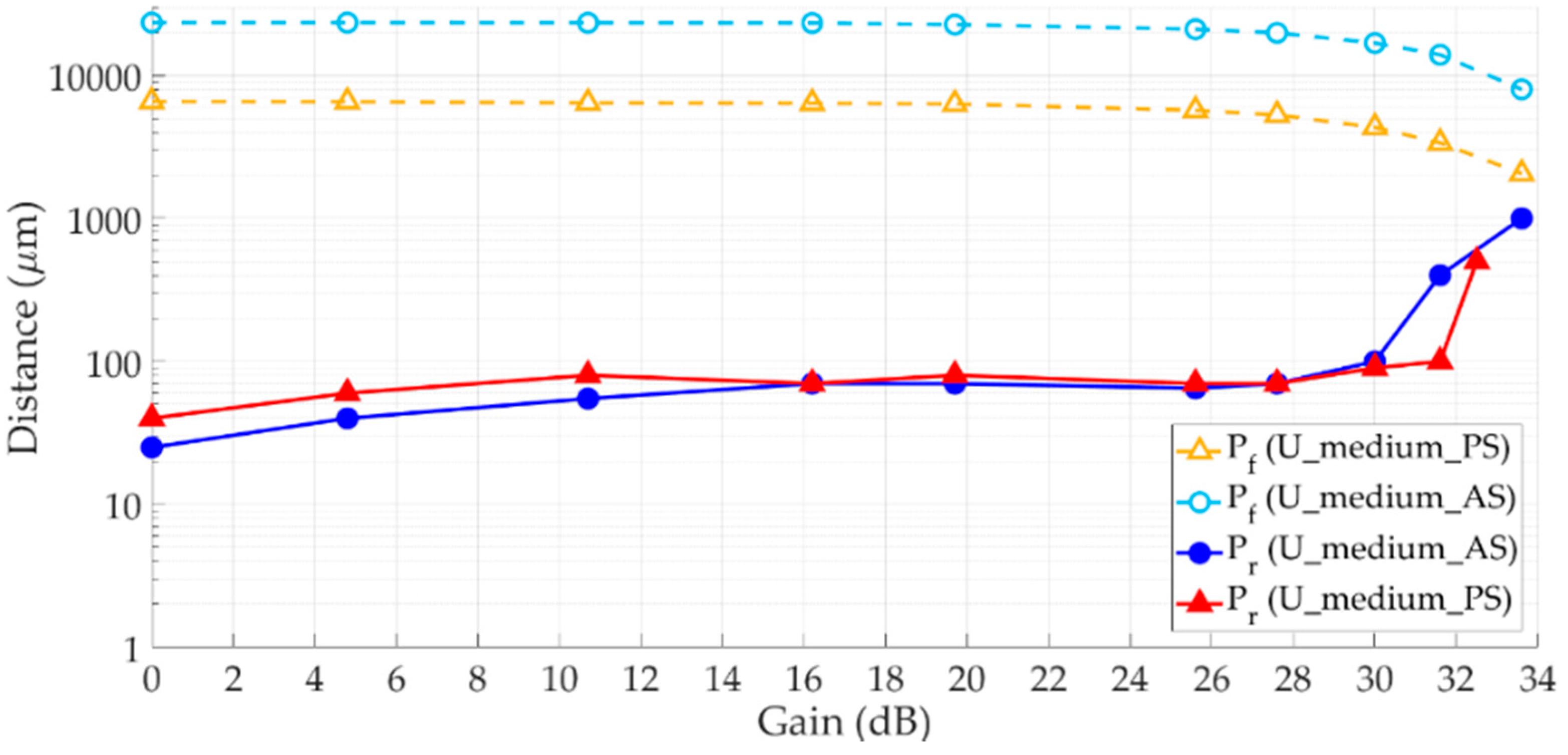
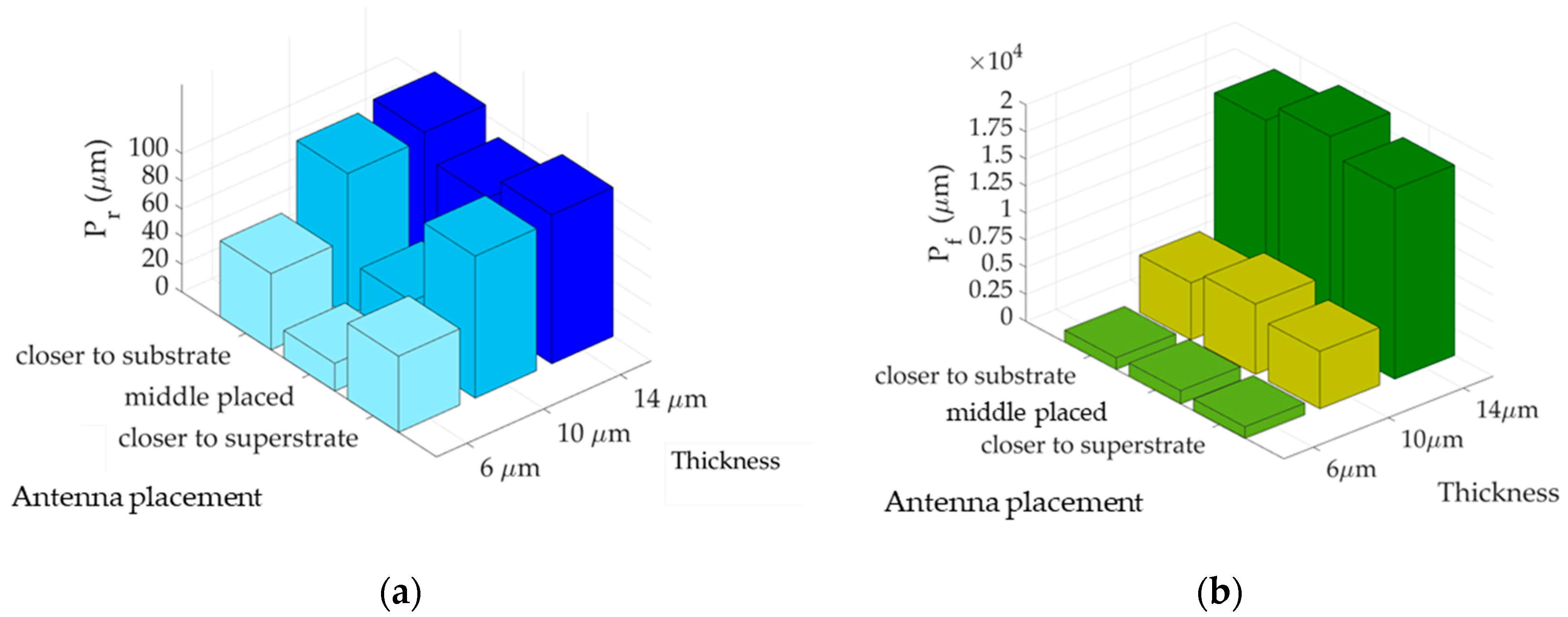



| Parameter | Value |
|---|---|
| Δh | thin: 6 μm; medium: 10 μm; thick: 14 μm |
| Δhup | 2 μm |
| Δhdown | 625 μm |
| n0 | 1.44 (SiO2) |
| ntop | 1.5 (plastic) |
| nup | 1 (Air) or 2 (passivation) |
| ndown | 3.47 (Si, perfect metal otherwise) |
| nbottom | 1.5 (plastic, perfect metal otherwise) |
© 2018 by the authors. Licensee MDPI, Basel, Switzerland. This article is an open access article distributed under the terms and conditions of the Creative Commons Attribution (CC BY) license (http://creativecommons.org/licenses/by/4.0/).
Share and Cite
Fuschini, F.; Barbiroli, M.; Zoli, M.; Bellanca, G.; Calò, G.; Bassi, P.; Petruzzelli, V. Ray Tracing Modeling of Electromagnetic Propagation for On-Chip Wireless Optical Communications. J. Low Power Electron. Appl. 2018, 8, 39. https://doi.org/10.3390/jlpea8040039
Fuschini F, Barbiroli M, Zoli M, Bellanca G, Calò G, Bassi P, Petruzzelli V. Ray Tracing Modeling of Electromagnetic Propagation for On-Chip Wireless Optical Communications. Journal of Low Power Electronics and Applications. 2018; 8(4):39. https://doi.org/10.3390/jlpea8040039
Chicago/Turabian StyleFuschini, Franco, Marina Barbiroli, Marco Zoli, Gaetano Bellanca, Giovanna Calò, Paolo Bassi, and Vincenzo Petruzzelli. 2018. "Ray Tracing Modeling of Electromagnetic Propagation for On-Chip Wireless Optical Communications" Journal of Low Power Electronics and Applications 8, no. 4: 39. https://doi.org/10.3390/jlpea8040039
APA StyleFuschini, F., Barbiroli, M., Zoli, M., Bellanca, G., Calò, G., Bassi, P., & Petruzzelli, V. (2018). Ray Tracing Modeling of Electromagnetic Propagation for On-Chip Wireless Optical Communications. Journal of Low Power Electronics and Applications, 8(4), 39. https://doi.org/10.3390/jlpea8040039







